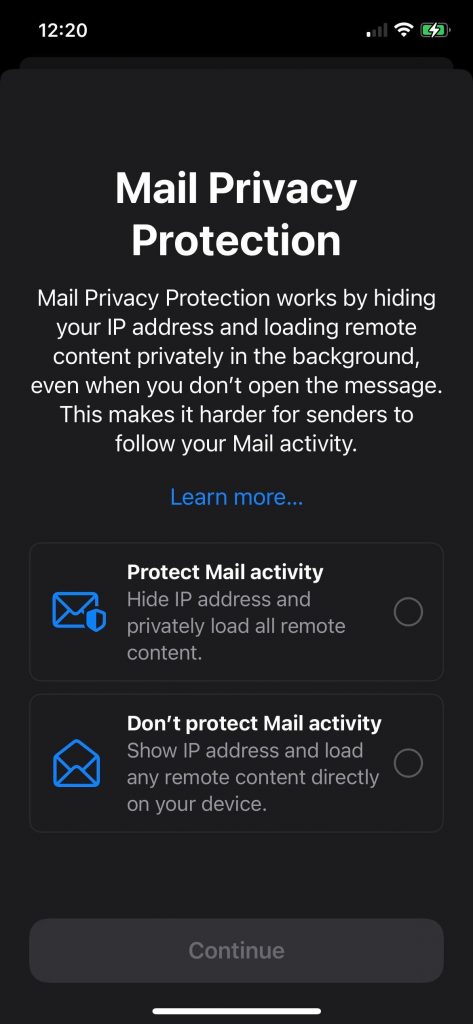Unless you’ve been living on a remote island somewhere you’ll know that on September 20th Apple’s iOS 15 update was launched. It contains a feature call Mail Privacy Protection (MPP) which – amongst other things – will eliminate the ability to accurately track email open rates.
For the uninitiated, email opens are recorded using a tiny image in the email code. When the email is opened, that image loads, which tells the sender an email was opened, by whom, when, where and on what device. What Apple have done is add a ‘middle man’ into the mix. Emails are now firstly routed through Apple’s proxy servers to pre-load email content – including the tracking image – before serving the email to the original recipients.
This will make it impossible to tell whether real people or Apple opened your emails. We won’t know when the open happened, where the person is located or which Apple device they use. That means no more mobile vs. desktop insights!
For some email campaigns, we are already seeing the percentage of emails where the device data is being hidden by MPP at 20%. That’s double what it was a week ago and we expect this to increase as more Apple users install the latest iOS 15 update.
What will the adoption rate be?
Whilst MPP won’t be switched on by default, when opening email for the first time after installing iOS 15, you are presented withprf a screen asking if you would like to be tracked or not.

When Apple launched its App Tracking Transparency tool in April, 96% of people opted out. There is no reason to expect Mail Privacy Protection will be any different. I mean, who in a post-GDPR and Cambridge Analytica, Facebook etc. world would say ‘Yes, please track me’!
So, from now on you can expect to see your open rates jump. You just won’t know if any of that increase is real. With estimates putting Apple proxy opens at 75% you can be sure this jump isn’t because your audience suddenly loves you more.
…and why does that matter?
The upshot of this is that open rates will no longer be a useful metric when measuring subscriber engagement. This has repercussions for a range of emails you may already be sending, including:
- A/B testing subject lines using opens to determine the winner.
- Targeting based on the last open date.
- Automated workflows and journeys that rely on someone opening an email.
- Send time optimisation based on previous open times.
- Countdown timers may also show incorrect times as they will start at the Apple open rather than the real recipient open time.
- Local content driven by opens or IP addresses, such as the nearest store location (although this is more of an issue in large geographies like the USA rather than the UK).
- AI platforms that use email opens in their algorithm for creating optimised subject lines.
Going forward, list hygiene management using non-openers over time will become a challenge although as Apple can only cache images if the Mail app is running, it means those email addresses are valid.
There is a chance this could all backfire of course. The muddying of these waters will mean emails that are less targeted and none of us want that. We have all come to expect a high level of personalisation. Sometimes we even claim we are happy to trade a degree of privacy for an improved experience. However, I can’t see this becoming a big enough issue to prompt large numbers of people going into mail settings on their iPhones and switching MPP off again.
So what can we do to best prepare our email marketing for the future?
Who’s who?
The first step is to understand the email client breakdown of your audience to determine who uses an Apple device. You can also create a reliable opens audience for non-Apple Mail users as you can still use the open metric here.
Update and remind people about your email preference centre. Give them a range of choices on how they would like receive emails from you. And – as always – keep your email list clean to stay on top of deliverability.
Focus on click rates
The goal of any campaign is most likely not about how many people open an email but how many make a purchase and in between the email open and the website is the click. We are already focused on click rates and now we’ll need to rely on these even more. The open-to-click metric will also need changing to clicks compared to emails sent.
Expand your engagement-based segments
As open rates become increasingly unreliable, double-down on your engagement criteria to include clicks, web visits and purchase activity. The numbers who meet these criteria will naturally be smaller but it’s a good way to continue having highly-targeted engagement segments.
Segment your contacts based on how far they are on their path to purchase. This provides another data-driven measure of intent that can be used for targeting.
Add new channels
Other channels like SMS and push notifications can help expand your reach. In 2020, the number of SMS messages sent increased nearly 400% with conversion rates doubling.
For web push notifications, the increase was around a 30% conversion rate, which is nearly five times what it was the previous year.
Whilst you should consider these channels to mitigate no longer having complete email open data, neither SMS or push notifications have open rates at all so have always had to measure success in terms of conversions. It’s also worth reminding ourselves that email is still at the top of the pile in terms of ROI. A drop in the accuracy of measuring open rates isn’t going to change that.
Shopping data
Place more importance on customer purchases using recency, frequency, and monetary (RFM) data.
If you don’t already have one, create a customer lifecycle program which can identify customer stages based on all of these other metrics. It will allow you to build and automate data-driven campaigns based on purchase behaviour.
Be creative
Be adaptable so you are able to move quickly when things change. We should always be looking for new ways to provide value to our customers. The ultimate goal is revenue from initial and repeat purchases, not open rates.
As marketers, we have all the data we need to help understand customer preferences which should allow for smarter promotions overall. The open engagement metric may be more unreliable, but the metrics of clicks and conversions remain unchanged.
Hide My Email – should I worry?
Another part of Mail Privacy Protection allows people to hide any of their email addresses (e.g., Hotmail/Outlook, Gmail, etc.) by generating unique, random icloud.com email addresses that forward to their real email address. These are used only once. If people hide their email from multiple companies, they will have generated multiple fake emails (one for each website).
icloud email addresses aren’t anywhere near as prevalent as Gmail or Hotmail/Outlook. Nonetheless it’s worth tracking your email data at a domain level to check for growth.
These fake email addresses can be deleted which means next time you mail them they will hard bounce and, If you get a lot of these, your email deliverability will suffer.
Another challenge is tying email activity to purchases when, say, someone signs up for your newsletter with Hide My Email but then later make a purchase using their real email address.
Whilst it is early days, Hide My Email is unlikely to gain enough traction to become a problem. After all, there have been similar services available for years. Also, if you’re seeing lots of new random icloud addresses appear in your database then you have a more fundamental trust issue. These people saw enough of a reason to hide their real address from you in the first place.
The future is bright
If your core objective of marketing is to provide the right value to the right customer at the right time, you shouldn’t have too much to worry about.
However, Apple’s iOS 15 update is certainly making it more challenging. Apple may be leading the way but expect other companies to follow suit. We should all see this as an opportunity to look at the other ways customer engagement and behaviour can be measured and improved.
Ultimately what Apple has done is a good thing. We have all had our trust eroded over the years by unscrupulous marketing. Spammers often use harvested email addresses. There is ever-pervasive advertising that follows you around the internet. And the almost sinister use of AI algorithms that present us with filtered realities within social media platforms – just to keep us there longer so we see more ads.
In this brave new world it has become easy to forget the marketing fundamentals of building trust and respecting our customers. Apple have just given us a reminder.



